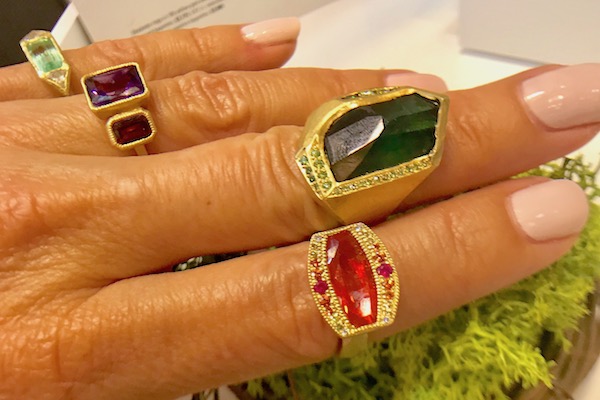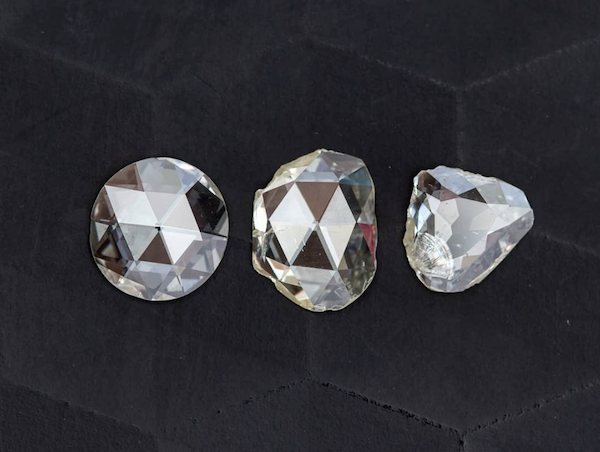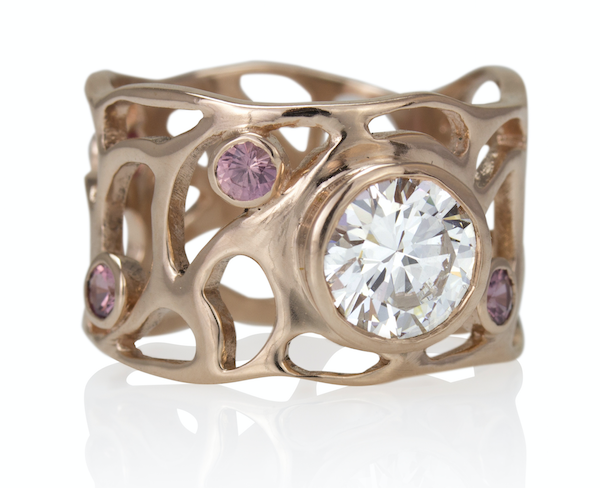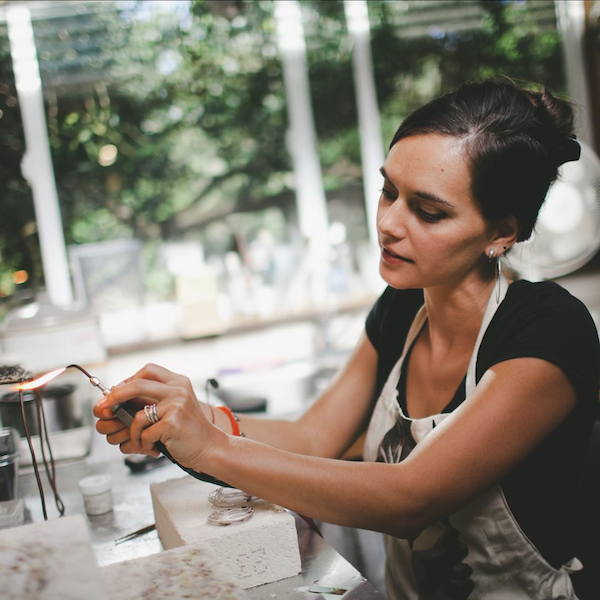“People don’t really get the definition of the word ‘ethical’ when it comes to stones,” jewelry artist Luana Coonen told me as we strolled the gem-lined aisles of the AGTA (American Gem Trade Association) show in Tucson. I know Luana goes to impressive lengths to insure her jewelry is ethically sourced, so I asked her to show me her trade route at the Tucson Gem Show.
Many of the folks we spoke to that day are making their way right now to another U.S. city – a windier one – to find the answers we were seeking: What does “ethical” really mean when it comes to jewelry?
This year’s Chicago Responsible Jewelry Conference opens Friday, October 19th – which happens to be this blog’s ninth birthday. I can’t think of a better way to celebrate The Jewelry Loupe’s almost-a-decade anniversary than by calling attention to the issues being discussed this week.
Speakers include heads of mining operations, jewelry distributors and makers, and organizations such as the Responsible Jewelry Council and Ethical Metalsmiths – all of whom built their brands around ethical sourcing, including designers Jennifer Dawes and Anna Bario of Bario Neal.

Collecting antique jewelry and gems is one way to ensure you’re not aiding unethical mining practices – and you know I’m all about that. But another is to buy from designers who buy from the handful of suppliers who guarantee a vetted supply chain.
It’s only recently that designers – let alone their customers – began to ask questions like the one Luana asks her suppliers: Can you show me where your material comes from?
A lot more are asking that now. A 2015 Nielson study showed 66 percent of consumers – and 73 percent of millennials – say they are willing to spend more on a product if it comes from a sustainable brand.
Luana recently asked Jared Holstein, co-owner of Perpetuum Jewels where she buys recycled diamonds, how he defines an ethical stone. “He told me, ‘I don’t really think there is such a thing as an ethical stone.’ I was impressed that he was willing to admit that.”

From a recent post on Perpetuum’s Instagram: “Around 80% of diamonds are mined by large scale, corporate mechanized mining operations exhibiting varying degrees of ethical and environmental stewardship. The remaining 20% or so of diamonds are mined ‘informally’ by millions of people working alluvial deposits, usually at a subsistence level and with little infrastructure.
“Geopolitical realities and steep global inequities mean these miners and their families tend to live under or near the poverty line. This is particularly true in Sierra Leone, which despite being rich in diamonds, has the world’s lowest life expectancy (51), and among the highest rates of both maternal and infant mortality.”
 Perpetuum contributes to Partners In Health, a global health delivery nonprofit that does lifesaving work in Kono, Sierra Leone – a diamond-mining town featured in the movie Blood Diamonds.
Perpetuum contributes to Partners In Health, a global health delivery nonprofit that does lifesaving work in Kono, Sierra Leone – a diamond-mining town featured in the movie Blood Diamonds.
Luana reports that her customers are starting to ask where her material comes from. “That’s such a good question to ask a designer,” she told me in Tucson. “This whole sustainable thing is changing. Everybody is like, wait a second, where did that stone come from? Where did that diamond come from? Ten years ago, nobody even thought to ask.”

Finding reliable sources for ethically mined stones is not easy, but it’s starting to get easier. Luana buys reclaimed and recycled diamonds from Perpetuum Jewels and colored stones – including Montana sapphires, ant hill garnets, and Malawi sapphires – mainly from Columbia Gem House.
“They’re totally vertically integrated,” she told me as we approached the Columbia Gem House booth at AGTA. “They run the whole system and I talked to them about it for a while. It’s all level one.”
I can vouch for that because I’ve been discussing this topic with the owner, Eric Braunwart, for years. Luana is interested only in “level one” sources, meaning those with a direct, traceable line from mine to cutter to dealer: full transparency. For this reason, she buys most of her material from only four carefully vetted vendors.

There are five levels of certified gemstones, she says, “everything from good to bad, up in the high range where it’s all certified but there are gaps in the process. I don’t get near the top. I only buy at the first level, the complete, absolute safety zone.”
If you want ethically sourced stones, there are going to be fewer options, she says, which actually makes life easier. “It’s like when you go to a restaurant and the menu is a million pages long? Sometime it’s easier if it’s just one page.”
When we reached the booth of Columbia Gem House, she held up a case of tiny faceted stones, tilting it so they flashed red. “Ant hill garnets!” she said. “The ants are just doing their thing. They’ll find a garnet and kick it out of the way and then people walk around and find it. This is my absolute favorite gemstone because it’s the most ethical you can possibly get – like, no human even touched this dirt!” she laughs. “And I love that deep red color.”

Owner Eric Braunwart will be moderating a panel on responsible gem cutting at this week’s conference. Eric has been struggling for 17 years to redefine standards for colored-stone mining, cutting and distribution, but millennial designers have only recently begun to seek him out – in droves. His booth at AGTA was inundated, not so much with the big-money sales neighboring vendors were negotiating, but by young designers who had made “ethically sourced” a central part of their brand.
When we spoke, he had already lined up 50 new accounts. “That’s unheard of at this show,” he said. “They’re buying an incredible array – fire opal, ruby, fancy sapphire, you name it. They don’t have a specific gemstone in mind when they come to me. They don’t come here for stones. They come here for traceable stones. They come to the booth because they heard we have that, so we talk.”
His new buyers are all under 30, Eric says, and posting about his stones on social media. “One will come and post about it, then three others show up and they post,” he said, mostly on Instagram, sometimes Facebook. The designers who followed the social media trail to his booth were open to everything he showed them. He’d sold “lots of tourmaline, but also things like andalucite and Oregon blue opal – things nobody had heard of.”
Gemstones you find at AGTA are often the best of the best and super expensive. “That’s not my customer base,” he says. “In fact, we intentionally leave inclusions in sapphire.”
These younger designers are not looking for the perfect royal blue flawless sapphire. “We sell – two to one – teal colored over blue,” he said with a shrug. “It’s a challenge because we still have to cut and sell to the trade, to jewelry stores, completely different from these young designers.”
Terminology is important, Luana insists. “Sustainable feels like a word you use on a website as a sales pitch, and recyclable feels like somebody who happens to be doing something funky,” she says. She makes jewelry that fits both descriptions, including fashion jewelry of butterflies and lichen encased in plastic recycled from CDs, as well as fine jewelry made with ethically mined gems.
The jewelry she makes with found objects wasn’t originally about saving the earth. It was more conceptual: challenging people to redefine what is precious and beautiful. “I think recycled and sustainable are two different approaches,” she says. With so many artists now using the words “recycled,” “ethical,” and “sustainable” to describe their work, this is probably a good time to clarify terms.
The most important term when it comes to gemstones, Eric says, is “transparent supply chain” – not responsible but transparent. “If you don’t build that, you don’t know if it’s ethical, you don’t know if it’s sustainable, you don’t know if it’s responsible. When someone says, ‘I have a responsible supply chain,’ people should ask: ‘But do you know where and how everything is produced?’ That’s the transparent part.” (You can find more of my conversation with Eric Brauwart here.)
So, happy birthday to me! My actual birthday falls a couple weeks (but a lot of years) before this blog’s, but today I wish bonne anniversaire to The Jewelry Loupe. May its tenth year bring some enlightenment. I’ll take that in any form, including strides toward a world where the beautiful jewelry we love is made with respect for the people who produce it and for this planet.

